Finding the best non-toxic sunscreen can be overwhelming. We rounded up the best natural, clean, and safe sunscreens for face and body that are also low-PUFA or PUFA free. Read on for the guide + get tips for how to choose the best clean sunscreen. Plus, learn more about the benefits of using sun care products that are low in polyunsaturated fatty acids.

If you’ve found yourself on a natural skincare blog, you likely already understand the importance of choosing a reef-safe mineral sunscreen for both your own health and for the environment.
However, finding a good non-toxic sunscreen that doesn’t leave an unsightly white cast (and isn’t chalky or greasy) is only one piece of the puzzle.
There are also other factors to consider. For instance, the polyunsaturated oils used in sun care products break down readily during sun exposure, creating an inflammatory reaction that can damage your skin (more on this later).
Below you’ll find some of the best organic, clean, chemical-free sunscreens that are also either very low in PUFA or PUFA free. You’ll find options for all skin tones from fair to dark, and all skin types from oily to dry.
Aside from specific product recommendations, this post includes information to help you determine what to look for when buying a natural sunscreen.
Read on to discover:
- What is non-toxic sunscreen?
- Benefits of choosing a low-PUFA sunscreen
- Recommendations for how to select a good safe sunscreen
- Best clean sunscreen recommendations for face and body
- What is non-toxic sunscreen?
- Why use a low-PUFA sunscreen?
- ☀️ Polyunsaturated fatty acids and sunburn
- How to choose a good clean sunscreen
- ☀️ Best Non-Toxic Sunscreens for Face and Body
- 🧡 Best Clean Tinted Sunscreen for Face: AKT Therapy D-Luxe Daily Bronzer SPF 30 Mineral Sunscreen with Vitamin D
- 🥥 Best Coconut Oil Sunscreen: All Good SPF 50 Mineral Sunscreen Butter
- 🧡 Best Tinted Coconut Oil Sunscreen: All Good SPF 50 Tinted Mineral Sunscreen Butter
- 🐮 Best Tallow Sunscreen for Face and Body: Fancy Farm Power Duo C+E Natural Zinc Sun Cream
- 🧡 Best Natural Tinted Sunscreen: Fancy Farm Power Duo C+E Natural Tinted Zinc Sun Cream
- 💄 Best Clean Sunscreen at Sephora: Juice Beauty SPF 30 Oil-Free Moisturizer
- 💦 Best Water-Resistant Zinc Sunscreen: Juice Beauty Water-Resistant SPF 30 Sport Sunscreen
- 🌊 Best Water-Resistant Sunscreen for Swimming: Stream2Sea Every Day Active Mineral Sunscreen SPF 45 with EcoSafe Zinc™
- 🧴 Best Non-Greasy Sunscreen with no White Cast: Ava Isa Sun-E Serum Drops SPF 35 Sunscreen
- 🤎 Best Hydrating Non-Toxic Sunscreen for Dark Skin (No White Cast): Ava Isa Every Morning Sunscreen SPF 30
- 🌈 Best Clean Tinted Sunscreen with Diverse Shade Range: Juice Beauty Stem Cellular CC Cream SPF 30
- 🧡 Best Drugstore Mineral Sunscreen for Face (Tinted): Think Everyday Face Sunscreen Naturally Tinted SPF 30
- 🧴 Best Non-Toxic Drugstore Sunscreen: Thinksport SPF 50 Clear Zinc Sunscreen
- 🍼 Best Non-Toxic Sunscreen for Babies: Pipette SPF 50 Mineral Sunscreen
- 💄 Best Lip Sunscreen with Zinc Oxide: Ava Isa Lip Whip SPF 15
What is non-toxic sunscreen?
Simply put, non-toxic sunscreen refers to sunscreen products that contain naturally-derived mineral UV filters in the form of zinc oxide or titanium oxide.
Also frequently called clean, organic, reef-safe, zinc-based, or physical sunblock, they all mean the same thing. These mineral-based shields work by reflecting and scattering UV rays on the surface of the skin, as opposed to chemical UV shields, which protect by absorbing UV radiation.
However, blocking UV rays is only one element of preventing skin damage. You may also want to consider a non-toxic sunscreen that’s low in polyunsaturated oils (also sometimes called seed oils).
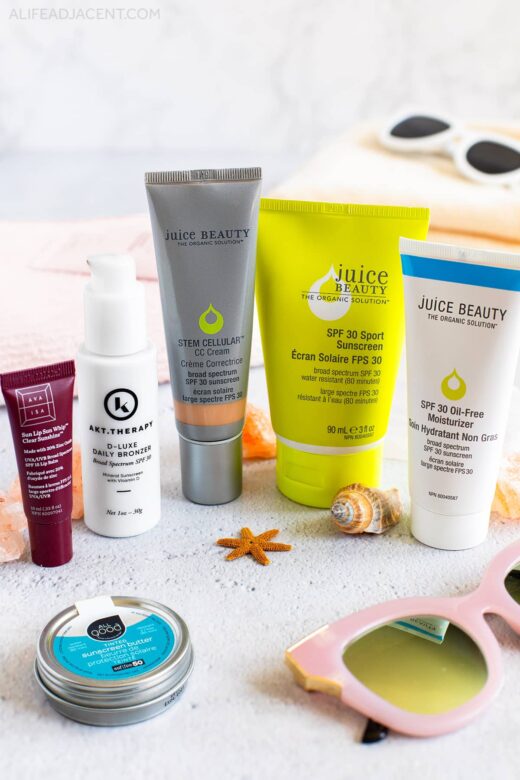
Why use a low-PUFA sunscreen?
You might already be familiar with the benefits of avoiding polyunsaturated fatty acids for your skin, but if low-PUFA skincare is new to you, see this post on how PUFA oils are aging your skin.
Put simply, the main reason to use a low-PUFA sunscreen is to avoid lipid peroxidation, an inflammatory process that destroys fatty acids (especially PUFAs) and damages the skin1,2.
Of all the fatty acids, polyunsaturated fatty acids (PUFAs) are the most susceptible to oxidation. The unstable double bonds in their structure makes them easily destroyed by light, heat, and oxygen. As such, PUFAs also break down readily in sunlight3.
When a PUFA oxidizes on our skin, it sets off a chain reaction of free radicals. These highly reactive, damaging molecules then go on to damage other tissues, generating even more free radicals in a vicious cycle called a free radical cascade2.
Over time, lipid peroxidation can permanently damage skin function, leading to inflammation and contributing to premature aging and skin cancer4. Oxidized polyunsaturated fatty acids are also responsible for lipofuscin formation (also known as sun spots)5.
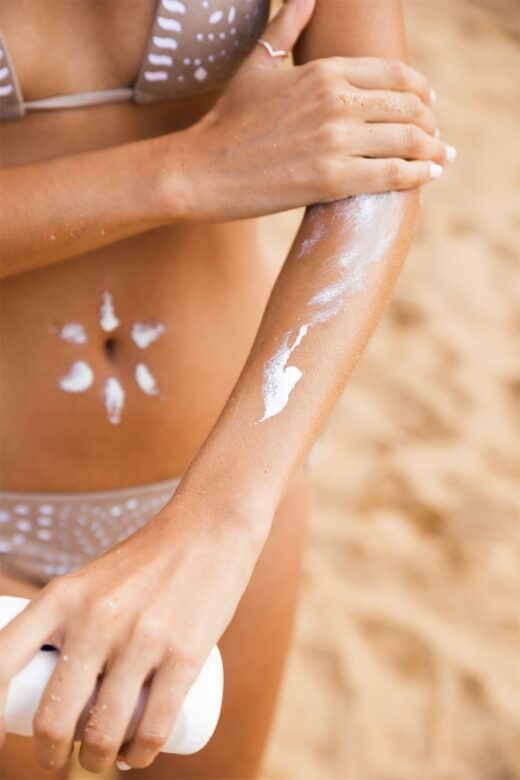
Polyunsaturated fatty acids and sunburn
What does this have to do with sunscreen? PUFAs may make our skin more susceptible to sun damage by making it less resilient to oxidative stress.
Sun damage occurs when UV damage outweighs the skin’s inherent antioxidant defences6. When the skin is exposed to UV radiation, unsaturated lipids on the skin (and in our sebum) are easily oxidized, creating free radicals that cause further inflammation7.
Oxidized PUFAs use up antioxidants such as vitamin E, which are also key for the skin’s sunburn defence8,9. And less antioxidant reserves in the skin makes it more susceptible to sun damage, including sunburn.
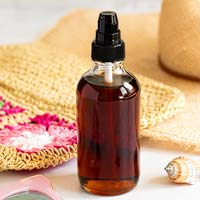
DIY Tanning Oil (Low-PUFA)
Do seed oils cause sunburn?
Evidence suggests that PUFAs may weaken the skin’s defences against UV damage, which can lead to sunburn.
Polyunsaturated fat intake (especially omega-6) has been associated with skin cancer risk in humans10. And in a study on rabbits, the group fed high-PUFA corn oil developed wrinkled, aged skin after sun exposure, while rabbits fed saturated coconut oil did not11.
To be clear, I’m not suggesting low-PUFA sunscreen will make you impervious to sunburn (and please do not take my opinions as medical advice).
But oils are absorbed into circulation regardless of whether they are consumed or applied topically12. And there is mounting anecdotal evidence that avoiding polyunsaturated oils makes you far less likely to sunburn (which you may be interested in looking into further).
How to choose a good clean sunscreen
There are a few things to consider when purchasing a natural sunscreen.
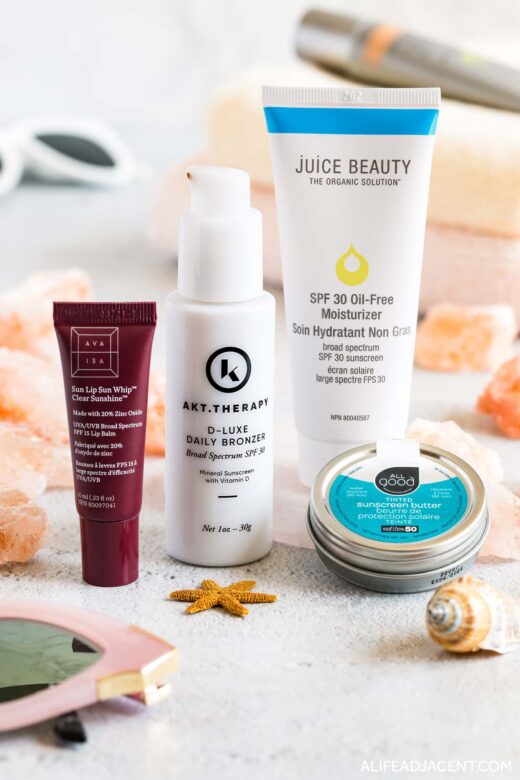
1. Low-PUFA
Polyunsaturated oils have infiltrated not only our food supply, but our skin care products as well. These highly processed oils include industrial seed oils and vegetable oils such as canola oil, soybean oil, safflower oil, grapeseed oil and sunflower oil.
But some oils are less easy to spot – for instance, almond oil, raspberry oil, carrot seed oil, rosehip oil, argan oil and apricot oil are just high-PUFA oils backed by marketing hype.
For a more detailed list of oils to avoid, along with low-PUFA substitutes (which include coconut oil, caprylic/capric triglycerides, grass-fed beef tallow and squalane), see this post.
2. Mineral based
The dangers of chemical sunscreen filters needs a separate post in itself, as they are linked to reproductive toxicity, endocrine disruption, and coral reef damage (and despite their use, melanoma rates continue to rise)14,15.
When choosing a clean sunscreen, avoid chemical UV filters such as avobenzone, oxybenzone, homosalate, octisalate (octyl salicylate) and octocrylene.
As well, take caution with “mineral sunscreens” that contain tridecyl salicylate and butyloctyl salicylate. These relatively new chemical UV filters are used to artificially inflate SPF levels by reducing skin redness – not by providing UV protection16.
Instead, look for a sunscreen formula with at least 20% non-nano zinc oxide, which provides broad-spectrum13 UVA and UVB protection at SPF 30. Titanium oxide and iron oxide, while helpful additions for blue light protection, are not broad-spectrum UV shields.
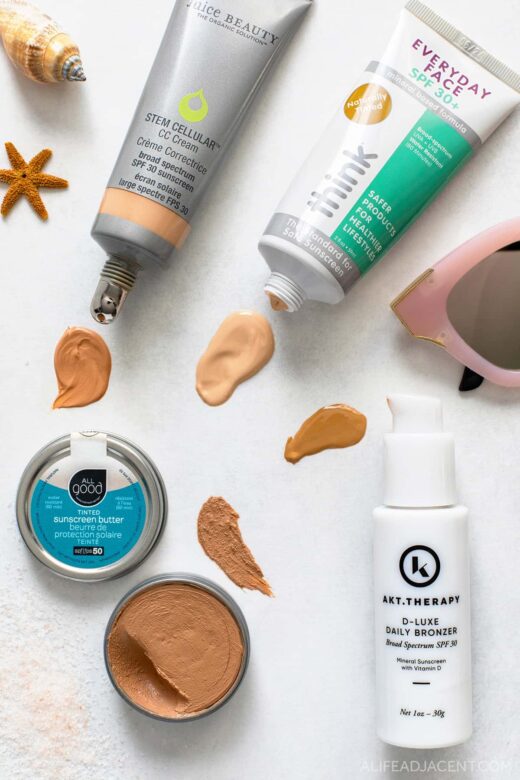
3. Antioxidant protection
UV filters are considered primary sun protection. A good non-toxic sunscreen should ideally also provide secondary protection in the form of antioxidants to bolster the skin’s defences against oxidative stress17.
Vitamin E and C work synergistically to protect from UV damage18, and carotenoids such as beta-carotene, lycopene, astaxanthin, and lutein may also help prevent UV-induced lipid peroxidation19.
4. Natural ingredients
This is where it can become tricky, because not every ingredient you can’t pronounce is unsafe. Ideally you want a clean sunscreen to have as few unpronounceable ingredients as possible, but this is where it’s important to research individual ingredients and not be sucked into overly puritanical scare tactics that have given “clean beauty” a bad name.
5. Fragrance-free
Fragrance compounds are not only sensitizing, they can also break down unpredictably in the presence of UV radiation, and oxidized essential oils and fragrance can cause skin irritation. Ideally, clean sunscreen should be fragrance-free or have minimal natural fragrance – coconut co2 extract is a good example of safe natural fragrance.
Best Non-Toxic Sunscreen for Face and Body
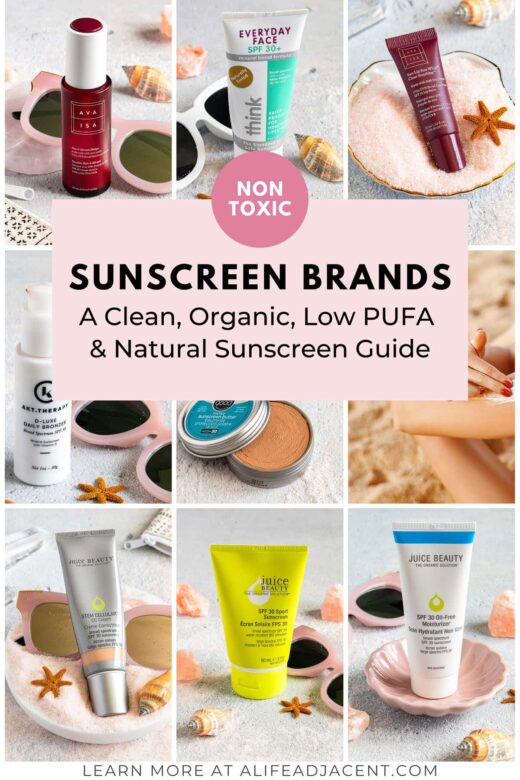
Best Clean Tinted Sunscreen for Face: AKT Therapy D-Luxe Daily Bronzer SPF 30 Mineral Sunscreen with Vitamin D
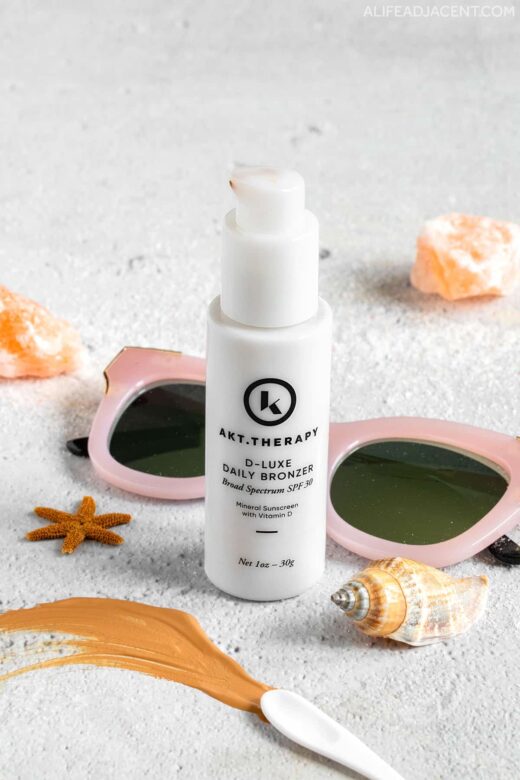
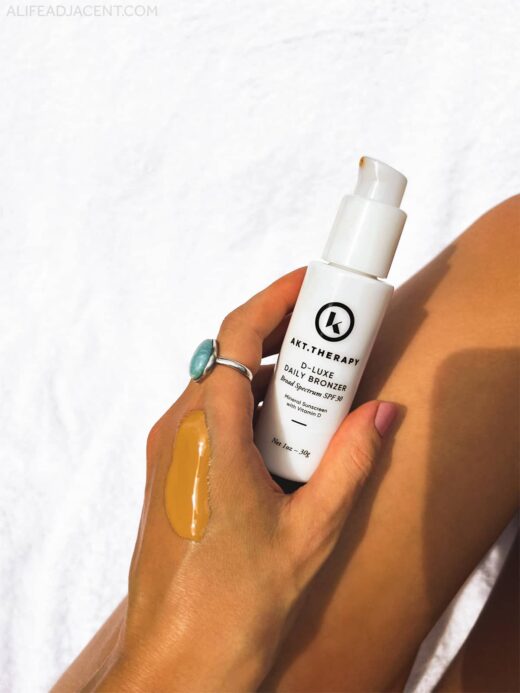
A sunscreen and liquid bronzer in one, AKT Therapy D-Luxe Bronzer has a dewy, luminous finish that’s ideal for dry skin, and it’s tinted with a warm bronze color for a natural, sun-kissed glow. (It also comes in a lighter shade called Desert Mallow.)
This silky, lightweight sunscreen is made with a base of nourishing olive oil and beeswax, with vitamins E and D for added UV protection and skin health.
I love this tinted sunscreen’s skin perfecting quality. It helps color correct and cover any redness or blemishes, so it replaces makeup in a minimal beauty routine, and I’ve used it daily for years now.
Finally, with only 6 ingredients, this sunscreen’s formula is ideal for those with very sensitive skin. As a bonus, it’s packaged in a beautiful recyclable glass bottle.
Buy from: AKT Therapy
Pros: Low-PUFA, antioxidants, no white cast, high zinc oxide (25%), suitable for very sensitive skin, no chemical preservatives
Cons: Only comes in 2 shades, not suitable for all skin tones, olive oil is high in oleic acid which may cause breakouts for acne-prone skin
Ingredients
Active Ingredient: non-nano Zinc Oxide (25%)
Inactive Ingredients: Aqua (Water), *Olea Europaea (Extra Virgin Olive) Fruit Oil, *Cera Alba (Beeswax), ‡Tocopherol (Vegetable Vitamin E), Cholecalciferol (Vitamin D3), Iron Oxides (CI 77491, CI 77492, CI 77499). *Organic ‡Non-GMO
Best Coconut Oil Sunscreen: All Good SPF 50 Mineral Sunscreen Butter
This is a simple, no nonsense coconut oil sunscreen and physical sunblock with 25% zinc oxide for high level SPF 50 protection. (If you’re looking for a sunscreen with no white cast, there’s also a tinted version.)
All Good Mineral Sunscreen Butter is made with a base of coconut oil, beeswax, and low-PUFA jojoba oil, with added vitamin E for free radical defence. Beeswax helps protect the skin and offer water-resistant properties.
As a bonus, it also contains calendula and chamomile to help calm and protect sensitive skin. It’s affordable, convenient, and travel-friendly, and it also comes in a mineral sunscreen stick for even easier application.
Pros: Very low-PUFA, added vitamin E, 25% zinc oxide, texture also works well for lip balm, plastic free packaging
Cons: Thicker balm texture that may not be everyone’s preference, not suitable for those who break out from coconut oil, leaves a white cast
Ingredients
Active Ingredient: Zinc Oxide 25% (Non-nanoparticle).
Inactive Ingredients: Organic Cocos Nucifera (Coconut) Oil, Organic Cera Alba (Beeswax), Organic Calendula Of cinalis (Calendula) Flowers infused in Organic Simmondsia Chinensis (Jojoba) Seed Oil, Non-GMO Tocopherol (Vitamin E), Matricaria Recutita (Chamomile).
Best Tinted Coconut Oil Sunscreen: All Good SPF 50 Tinted Mineral Sunscreen Butter
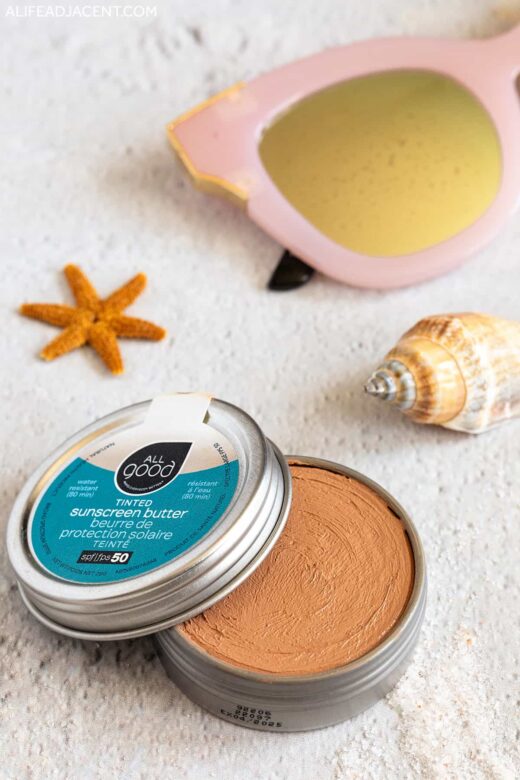
This rich and buttery tinted coconut oil sunscreen is colored with iron oxides for a warm bronze finish. It’s very moisturizing, with a base of only low-PUFA coconut and jojoba oils, vitamin E for added protection, and calendula to protect sensitive skin.
Coconut oil has high oxidative stability and natural sun protective properties, making it a great choice for low-PUFA sun protection. I like this one a lot, and I just rub it gently between my fingers to warm it up for easier spreadability.
Pros: Nourishing texture, low-PUFA, tinted for no white cast, zero waste packaging
Cons: Some find coconut oil sunscreens too heavy, and the tan color does not match all skin tones
Ingredients
Active Ingredients: Zinc Oxide 25% (Non-nanoparticle)
Inactive Ingredients: Organic Cocos Nucifera (Coconut) Oil*, Organic Cera Alba (Beeswax)*, Organic Calendula Officinalis Flowers* infused in Organic Simmondsia Chinensis (Jojoba) Seed Oil*, Iron Oxides (CI 77491), Iron Oxides (CI 77499), Octyldodecanol, Trihydroxystearin, Non-GMO Tocopherol (Vitamin E), Yellow Iron Oxide.
Best Tallow Sunscreen for Face and Body: Fancy Farm Power Duo C+E Natural Zinc Sun Cream
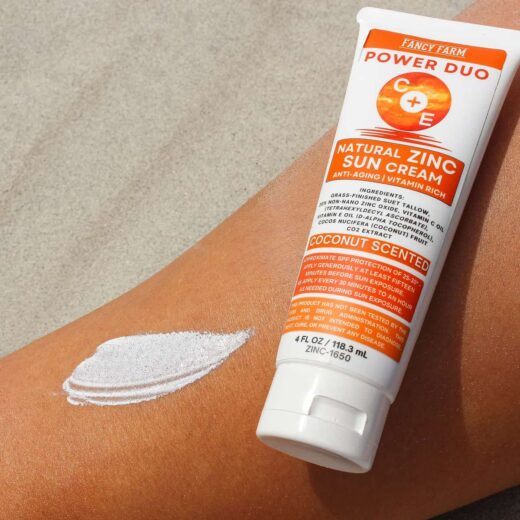
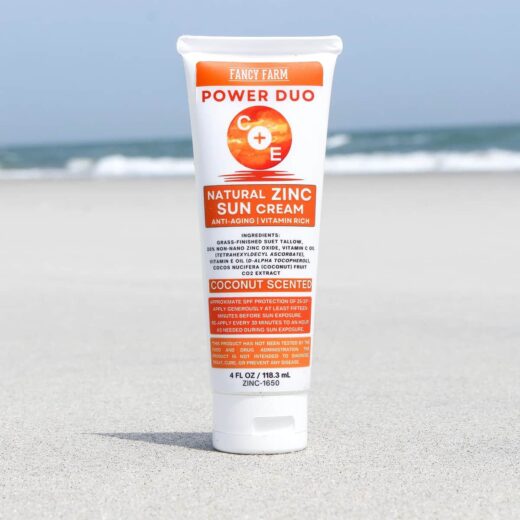
Handmade with love by a small, US-based business, Fancy Farm’s tallow sunscreen checks all the boxes, making it one of the best non-toxic sunscreens overall.
Those following a paleo, ancestral or Dr. Ray Peat-inspired skincare routine will appreciate this sunscreen made with low-PUFA grass-fed beef tallow, which is extremely nourishing to the skin and supplies vital fat-soluble vitamins.
Aside from its low-PUFA base, this clean sunscreen also contains vitamins E and vitamin C to bolster the skin’s UV defences and protect from lipid peroxidation. 20% non-nano zinc oxide protects from UV rays without chemical filters.
Its water-free formula gives it a long shelf life, and it doesn’t require preservatives, making it excellent for sensitive skin. It’s also scented with coconut co2 extract for a beachy, coconutty scent without synthetic fragrances.
Buy from: Fancy Farm
Pros: Low PUFA, contains vitamins E and C, suitable for face and body, packaged in renewable sugarcane tube, waterless formula
Cons: Tallow may trigger breakouts for some acne-prone skin types
Ingredients
Pastured Raised Grass-Finished Suet Tallow, 20% Non-Nano Zinc Oxide, Vitamin C Oil (Tetrahexyldecyl Ascorbate), Natural Vitamin E Oil (D-Alpha Tocopherol), Cocos Nucifera (Coconut) Fruit CO2 Extract
Best Natural Tinted Sunscreen: Fancy Farm Power Duo C+E Natural Tinted Zinc Sun Cream
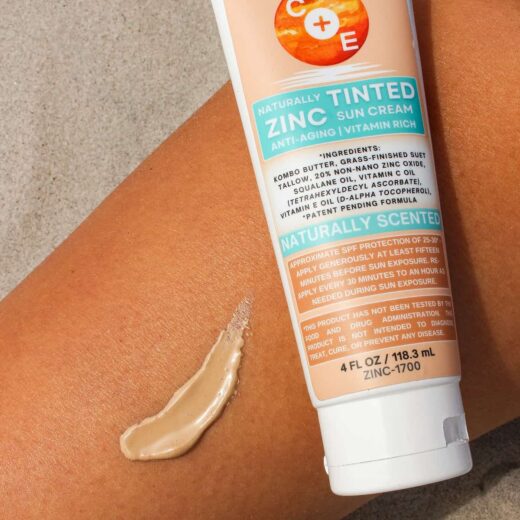
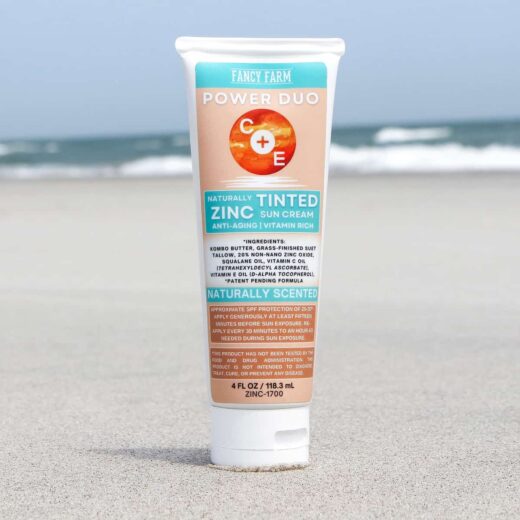
Perfect for those who love tallow skincare, this unique product is a tinted version of Fancy Farm’s tallow sunscreen. It contains an amazing blend of natural ingredients for sun protection, including grass fed tallow, PUFA free squalane, and fat-soluble anxitoidants vitamin E and C.
Instead of iron oxides or mica, this zinc sun cream get its all-natural tint from Kombo butter, an antioxidant rich, deeply colored low-PUFA butter from Ghana. Kombo butter has a deep chocolate-brown color for a truly natural tinted sunscreen without iron oxides or mica.
Buy From: Fancy Farm
Pros: Low PUFA, antioxidant protection, water-free formula for long shelf life, natural tint from Kombo butter without synthetic pigments
Cons: Kombo butter is a member of the nutmeg family, and its slightly spicy scent may cause skin irritation for those with very sensitive skin
Ingredients
Fair Trade Kombo Butter, Pastured Raised Grass-Finished Suet Tallow, 20% Non-Nano Zinc Oxide, Vitamin C Oil (Tetrahexyldecyl Ascorbate), Squalane Oil, Natural Vitamin E Oil (D-Alpha Tocopherol) (Patent Pending Formula)
Best Clean Sunscreen at Sephora: Juice Beauty SPF 30 Oil-Free Moisturizer

This oil-free, low-PUFA clean sunscreen is excellent for face and body. It contains vitamin E and C for added UV protection, and it’s packed with fruit extracts for even more antioxidant properties. (It also smells like fruity cereal.)
Juice Beauty’s non-toxic sunscreen base is comprised of only caprylic/capric triglycerides, making it not just low-PUFA, but PUFA-free. Its emulsifiers (sorbitan stearate and polyglyceryl-10 laurate) are also derived from saturated fatty acids.
This chemical free sunscreen has a thin, lightweight texture that spreads easily, and it dries down to a semi-matte dry touch finish. Caprylic/capric triglyceride (also known as MCT oil) is a non-comedogenic ester and not a true oil, making this sunscreen technically oil-free, which oily skin types may appreciate.
In terms of color, it’s lightly tinted with iron oxides to help minimize white cast, and it’s also available in a tinted mineral sunscreen (shade is called Sand). Also comes in a more affordable sport sunscreen for body (below).
Buy from: Amazon, Sephora, Ulta
Pros: Contains vitamins E and C for antioxidant protection, low-PUFA, comprised of only saturated fatty acids from caprylic and capric fatty acids, oil-free
Cons: Contains citrus essential oils, which may be irritating to very sensitive skin (surprisingly, it doesn’t irritate my highly reactive skin), slight white cast
Ingredients
Active Ingredients: Zinc Oxide 20%
Inactive Ingredients: Aloe Barbadensis (Aloe Juice), Caprylic/Capric Triglyceride, Pyrus Malus (Apple Juice), Vitis Vinifera (White Grape Juice), Sorbitan Stearate, Polyglyceryl-10 Laurate, Magnesium Sulfate, Tocopherol (Vitamin E), Magnesium Ascorbyl Phosphate (Vitamin C), Sodium Hyaluronate, Punica Granatum (Pomegranate Juice Extract), Algae Extract, Cucumis Sativus Extract (Cucumber Extract), Panthenol (Vtiamin B5), Citrus Medica Limonum (Lemon Fruit Extract), Iron Oxides, Phenethyl Alcohol, Ethylhexylglycerin, Citrus Reticulata (Mandarin Oil), Citrus Aurantium (Petitgrain Oil).
Best Water-Resistant Zinc Sunscreen: Juice Beauty Water-Resistant SPF 30 Sport Sunscreen
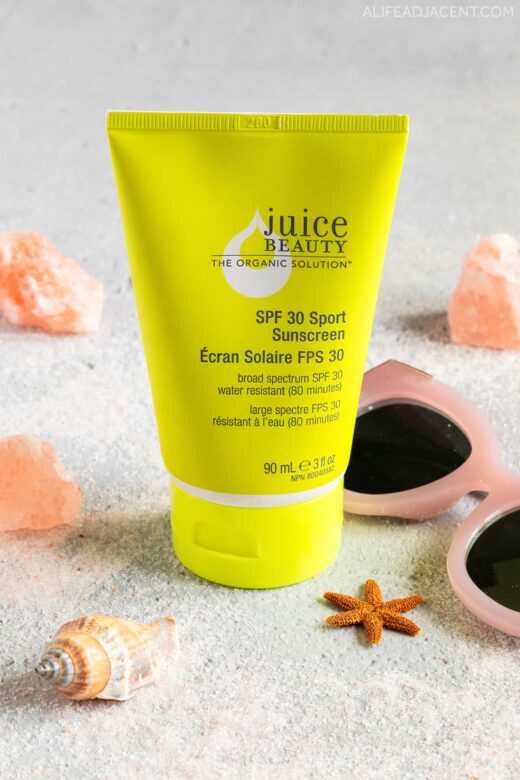
This moisturizing zinc-based sunscreen offers broad-spectrum, water resistant protection for face and body. It resists sweat and swimming, making it ideal for active outdoor lifestyles or days spent lounging at the beach or by the pool.
Made with a base of coconut oil, caprylic/capric triglycerides, and castor oil, this clean sunscreen is still low-PUFA despite containing a very small amount of sunflower oil. It also contains vitamin C and vitamin E for more protection.
The Sport Sunscreen has a nice creamy texture that’s highly spreadable and not overly greasy. Its water resistant properties come from low-PUFA thickeners sorbitan stearate (wax derived from stearic acid) and Hydrogenated Methyl Abietate (thickener derived from pine resin) to help give the formula viscosity and staying power.
Buy from: Amazon, Sephora, Ulta
Pros: Excellent waterproof properties, moisturizing texture ideal for dry skin types
Cons: Contains citrus essential oils and lemon extract, which may be irritating to sensitive facial skin. Thick texture may not be suitable for acne-prone skin. Leaves slight white cast
Ingredients
Active Ingredients: Zinc Oxide 20%.
Inactive Ingredients: Organic Juices Of Aloe Barbadensis (Aloe Juice)*, Pyrus Malus (Apple Juice)*, Vitis Vinifera (White Grape Juice)*, Cocos Nucifera (Coconut Oil)*, Caprylic/Capric Triglycerides, Sorbitan Stearate, Ricinus Communis (Castor Seed Oil), Hydrogenated Methyl Abietate, Polyglyceryl-10 Laurate, Magnesium Sulfate, Helianthus Annuus (Sunflower Seed Oil)*, Simmondsia Chinensis (Jojoba Seed Oil)*, Tocopherol (Vitamin E), Magnesium Ascorbyl Phosphate (Vitamin C), Citrus Limonum (Lemon Extract), Iron Oxides, Phenethyl Alcohol, Ethylhexylglycerin, Citrus Reticulata (Mandarin) & Citrus Aurantium (Petitgrain) Pure Essential Oils.
Best Water-Resistant Sunscreen for Swimming: Stream2Sea Every Day Active Mineral Sunscreen SPF 45 with EcoSafe Zinc™
Suitable for face and body, this water-resistant all mineral sunscreen is non-greasy, non-comedogenic, and contains a blend of antioxidants to nourish and protect skin during sun exposure.
It’s made with low-PUFA ingredients such as olive squalane, coco-caprylate/caprate and coconut oil. It also comes in 4 varieties: clear, tinted, shimmer, and kids sunscreen.
Stream2Sea is the only mineral based sunscreen that’s tested and proven safe for aquatic life. Its unique natural formula is also said to work even better after swimming, so it won’t wash off after a dip in the sea or pool.
This reef-safe clean sunscreen contains 19% zinc oxide for broad-spectrum protection. Because it creates a long-lasting, water-resistant barrier on the skin, it’s also classified as SPF 45.
Buy from: Stream2Sea, Amazon
Pros: Low-PUFA, Hawaii safe, proven safe for coral reefs and aquatic life, contains antioxidants
Cons: May leave a white cast on some skin tones
Ingredients
Active Ingredients: Zinc Oxide 19% (non-nano, EcoSafe Zinc™)
Inactive Ingredients: Deionized Water, Aloe Barbadensis Leaf Juice*, Coco-Caprylate/Caprate, Isoamyl Laurate, Vegetarian Glycerin, Polyglyceryl- 3 Oleate, Propanediol, Polyhydroxystearic Acid, Diisostearoyl Polyglyceryl-3 Dimer Dilinoleate, Mica, Caprylic/Capric Triglyceride, Sodium Chloride, Ethyl lauroyl arginate HCl, Jojoba Esters, Olive Squalane Oil, Extracts of Alaria Esculenta (Wakame Seaweed), Olea Europa (Olive) Leaf*, Camellia Sinenis (Green Tea) Leaf*, Ocimum Tinuiflorum (Tulsi) Leaf*, Cocos Nucifera (Coconut) Oil, Curcuma Longa (Turmeric) Root* Extract, Tetrasodium Glutamate Diacetate, Mixed Tocopherols, Sodium Stearoyl Glutamate, Silica, Xanthan Gum *Organic Ingredients
Best Non-Greasy Sunscreen with no White Cast: Ava Isa Sun-E Serum Drops SPF 35 Sunscreen
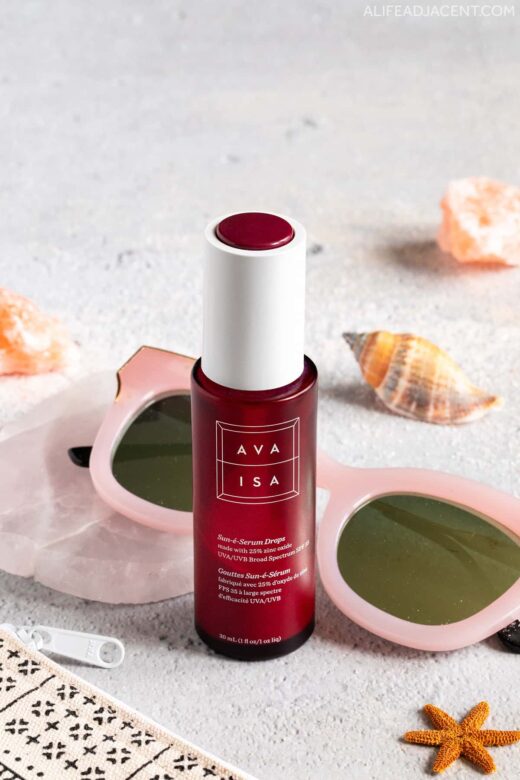
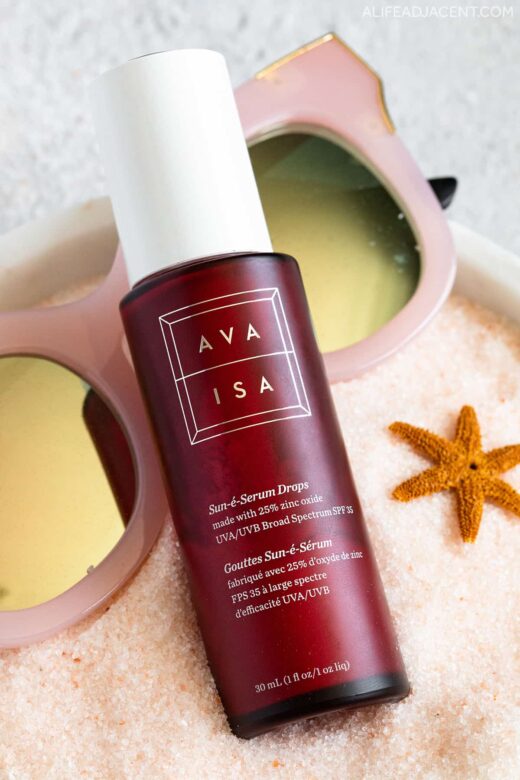
Mineral sunscreens often get a bad rap for greasy, pore-clogging formulas or leaving a ghostly white finish. Zinc oxide’s white cast makes finding a safe, non-toxic sunscreen particularly difficult for darker skin tones.
But Ava Isa Sun-E Serum tackles both issues. According to the brand, this innovative natural sunscreen serum applies transparently on all skin tones from Fitzpatrick Skin Types 1-6, despite containing 25% zinc oxide for high level UV protection.
It’s hard to find a mineral sunscreen with no white cast, but this product is also non-greasy, with a unique, lightweight serum texture that feels more like skincare than SPF. Oily skin types will appreciate that the formula dries down to a silky, matte finish that doesn’t feel heavy or greasy.
Finally, this zinc sunscreen serum also contains Micah® (Bis Cyano Butylacetate Anthracenediylidene), a novel ingredient that acts as an antioxidant to protect against UV-induced oxidative stress and blue light.
Buy from: The Sunscreen Company, Well.ca
Pros: Suitable sunscreen for dark skin with no white cast, non-greasy texture for oily skin, added antioxidants to help protect from UV light and blue light
Cons: Contains safflower oleosomes, so it’s not completely PUFA-free – however, most of the formula is comprised of caprylic/capric triglycerides, coconut alkanes, and coco-caprylate, all of which are saturated fatty acids
Ingredients
Active Ingredients: 25% Zinc Oxide
Inactive Ingredients: Caprylic/Capric Triglyceride, Glyceryl Isostearate, Polyhydroxystearic Acid, Polylactic Acid, Coconut Alkanes, Coco-Caprylate/Caprate, Carthamus Tinctorius Oleosomes, Aqua, Hydrogenated Vegetable Oil, Cellulose, Sorbitan Oleate, Polyglyceryl-6, Polyrincinoleate, Polyglyceryl-2 Isostearate, Disteardimonium Hectorite, Bis Cyano Butylacetate Anthracenediylidene (Micah)
Best Hydrating Non-Toxic Sunscreen for Dark Skin (No White Cast): Ava Isa Every Morning Sunscreen SPF 30
This innovative mineral sunscreen combines skin barrier repair with sun protection in an easily spreadable formula. It goes on glossy and smooth, blending to clear on all skin tones with no white cast, making this sunscreen another excellent option for darker skin tones.
With a high 25% zinc oxide, this reef-friendly, all-mineral sunscreen also provides a high level of broad-spectrum UV protection. Dry and sensitive skin types will appreciate this deeply hydrating mineral sunscreen with a lightweight, non-greasy texture.
It contains cholesterol from up-cycled lambswool (cruelty-free) to provide incurable skin barrier repair and hydration. Cholesterol is also a pre-cursor to vitamin D in the skin, which as we know has many benefits.
Buy from: The Sunscreen Company
Ingredients
Active Ingredients: 25% Zinc Oxide
Inactive Ingredients: Aqua, Coco-Caprylate/Caprate, Polyglyceryl-3 Polyricinoleate, Isostearic Acid, Caprylic/Capric Triglyceride, Propanediol, C13-15 Alkane, Dimethicone/Vinyl Dimethicone Crosspolymer, TMP Lauryl Dimethicone, Caprylhydroxamic Acid, 1,2-Hexanediol, 7-Dehydrocholesterol (not vegan), Sodium Chloride, Cerium Oxide.
Best Clean Tinted Sunscreen with Diverse Shade Range: Juice Beauty Stem Cellular CC Cream SPF 30
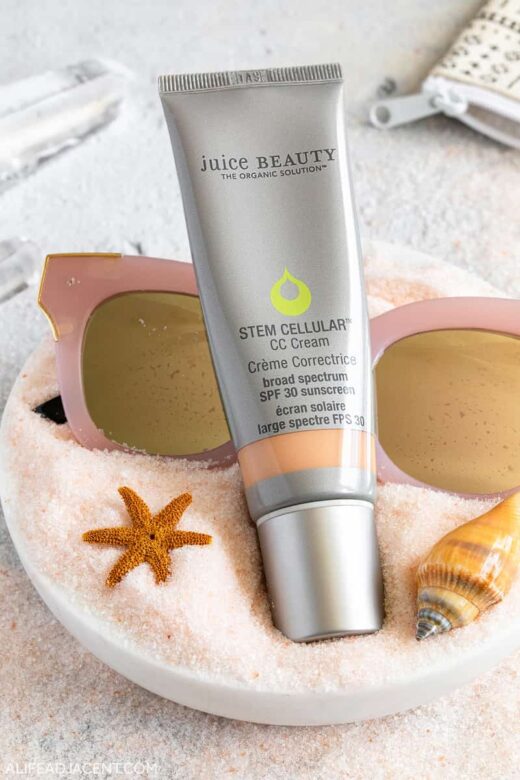
Tinted sunscreens often come in 1 or 2 shades that don’t suit all skin tones. But Juice Beauty Stem Cellular CC Cream offers 7 shades to suit a variety of skin colors, making it the best shade range for low-PUFA, reef-safe mineral sunscreen without chemical sunscreen filters.
It offers 20% non-nano zinc oxide for SPF 30 sun protection. It’s also a 12-in-1 multitasking color correcting cream, offering anti-aging, sun-protective properties along with moisture, coverage, and a glowing skin finish.
Similar to Juice Beauty’s Sport Sunscreen formula, the CC Cream is mostly comprised of coconut oil and saturated caprylic and capric fatty acids, with castor oil, sunflower oil, and jojoba oil in smaller amounts.
High-PUFA sunflower oil appears towards the bottom of the ingredients list after the emulsifier polyglyceryl-10 laurate, which suggests there’s barely any sunflower oil in the formula at all.
Buy from: Amazon
Pros: Skin-perfecting, color-correcting, antioxidants, 20% zinc oxide
Cons: Strong scent from citrus essential oils that may irritate sensitive skin types
Ingredients
Active Ingredients: Zinc Oxide 20%
Inactive Ingredients: Organic Aloe barbadensis juice*, cocos nucifera (organic coconut) oil*, pyrus malus (organic apple) juice*, vitis vinifera (organic white grape) juice*, caprylic/capric triglyceride†, sorbitan stearate, ricinus communis (castor seed) oil+, polyglyceryl-10 laurate, magnesium sulfate, helianthus annuus (organic sunflower) seed oil*, simmondsia chinensis (organic jojoba) seed oil*, tocopherol (Vitamin E)+, magnesium ascorbyl phosphate (Vitamin C), sodium hyaluronate†, malus domestica (apple) fruit cell culture extract+, vitis vinifera (grape) fruit cell extract+, citrus medica limonum (lemon) leaf cell extract+, phenethyl alcohol, ethylhexylglycerin†, citrus reticulata (mandarin) oil+, citrus aurantium (petitgrain) oil+. May contain: iron oxides (CI 77491, CI 77492, CI 77499).
Best Drugstore Mineral Sunscreen for Face (Tinted): Think Everyday Face Sunscreen Naturally Tinted SPF 30
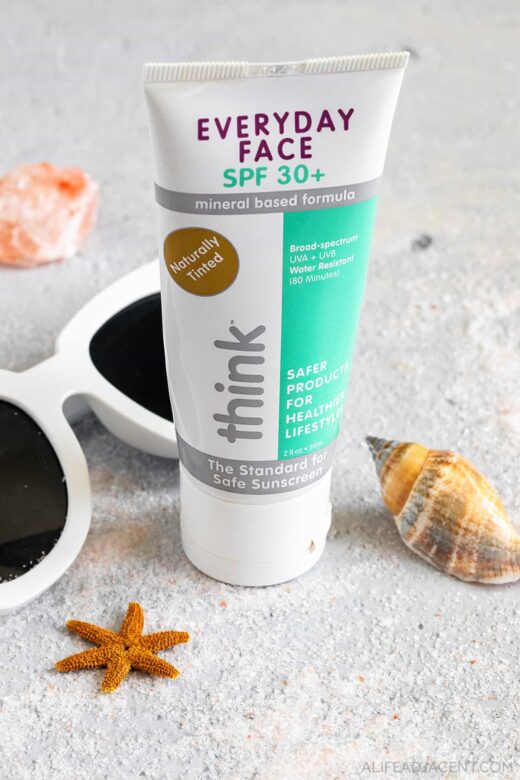
Think’s naturally tinted reef-safe zinc sunscreen is widely available and affordable. It has 20% non-nano zinc oxide with SPF 30, and it has an easily spreadable, lightweight formula with a subtle iron oxide tint.
While not PUFA free, it’s comprised of mostly capylic/capric triglyceride and hydrogenated castor oil, with a few higher PUFA oils (sunflower, raspberry, and cranberry) towards the bottom of the ingredients list.
Buy from: Amazon
Pros: Contains vitamin C and vitamin E, 20% zinc oxide, sunscreen without coconut oil so it’s not overly greasy
Cons: Contains dimethicone, which some people prefer to avoid. Also contains grapefruit essential oil which may be irritating
Ingredients
Active Ingredients: Zinc Oxide 20% (Non-nano)
Inactive Ingredients: purified water, aloe barbadensis leaf juice, capric caprylic triglycerides, sorbitan stearate (coconut based), pine wood resin, vegetable glycerin, cetyl dimethicone, hydrogenated castor oil, magnesium sulfate (epsom salt), sunflower oil, jojoba oil, ascorbic acid (vitamin c), tocopherols (vitamin e), olive oil, raspberry seed oil, cranberry seed oil, hyaluronic acid (made from vegetable), currant, citrus paradisi, iron oxide
Best Non-Toxic Drugstore Sunscreen: Thinksport SPF 50 Clear Zinc Sunscreen
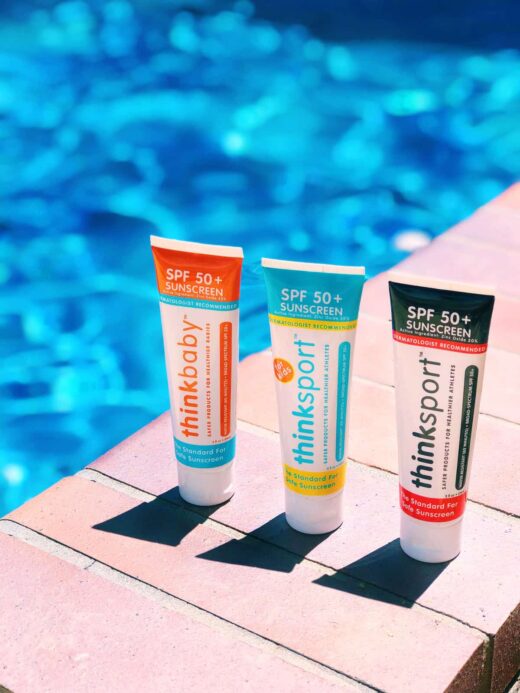
Thinksport’s SPF 50 Clear Zinc Sunscreen is a family-friendly sweat and water-resistant safe sunscreen formulated to leave a minimal white cast.
It has 20% zinc oxide for broad-spectrum UV protection without chemical SPF boosters, and a long lasting formula that’s ideal for an active outdoor lifestyle. Like the other Think formula, this mineral sunscreen’s base is mostly low-PUFA oils.
Buy from: Amazon
Pros: Water-resistant, high level of protection (SPF 50), contains vitamin E
- Cons: Not PUFA free, contains grapefruit oil
Ingredients
Active Ingredient: Zinc Oxide 20% (Non-nano)
Inactive Ingredients: purified water, caprylic/capric triglyceride, polyglyceryl-4 isostearate, glycerin, hydrogenated glyceryl abietate, hexyl laurate, cetyl dimethicone, aloe barbadensis leaf juice, hydrogenated castor oil, magnesium sulfate, helianthus annuus (sunflower) seed oil, simmondsia chinensis (jojoba) seed oil, tocopherol, olea europaea (olive) fruit oil, rubus idaeus (raspberry) seed oil, vaccinium macrocarpon (cranberry) seed oil, sodium hyaluronate, carica papaya (papaya) fruit extract, ribes nigrum (black currant) extract, citrus paridisi (pink grapefruit) peel oil, sorbitan sesquioleate, caprylhydroxamic acid, triethoxycaprylylsilane, glyceryl caprylate.
Best Non-Toxic Sunscreen for Babies: Pipette SPF 50 Mineral Sunscreen
Not just for babies, this clean and non-toxic mineral sunscreen is ideal for the whole family (at a very affordable price). It contains 20% zinc oxide for broad-spectrum mineral UV protection that’s suitable for delicate baby skin.
Because it’s formulated for sensitive skin, this clean sunscreen also contains gentle, non-irritating ingredients such as skin-soothing bisabolol, and extra antioxidant protection from ferulic acid and wild gooseberry.
It has a base of PUFA free capric/caprylic triglycerides and sugarcane-derived squalane for an oil-free, silky texture. This lightweight, broad spectrum sunscreen leaves a dewy skin finish.
Where to Buy: Amazon
Pros: Gentle sunscreen formula for babies and sensitive skin, extra antioxidants and soothing ingredients
Cons: Doesn’t contain vitamin C or vitamin E, leaves white cast
Ingredients
Active Ingredients: Zinc Oxide (20%)
Inactive Ingredients: Water, Caprylic/Capric Triglyceride, Squalane, Glycerin, Cetearyl Alcohol, Methyl Dihydroabietate, Sorbitan Olivate, Cetyl Palmitate, Coco-Glucoside, Ethyl Ferulate, Caprylyl/Capryl Glucoside, Lecithin, Bisabolol, Physalis Angulata Extract, Xanthan Gum, Acacia Senegal Gum, Sodium Gluconate, Isostearic Acid, Polyhydroxystearic Acid, 1,2-Hexanediol, Polyglyceryl-3 Polyricinoleate, Hydroxyacetophenone, Caprylyl Glycol
Best Lip Sunscreen with Zinc Oxide: Ava Isa Lip Whip SPF 15

When it comes to protecting your skin from the sun naturally, don’t forget your lips. This silky mineral lip balm contains broad-spectrum UV protection from zinc oxide and a glistening, glossy finish.
This isn’t your typical whitening zinc oxide lip balm – it’s more of a sunscreen lip gloss, and it doesn’t leave a noticeable white cast.
But it’s not just for lips, because this multi-tasking SPF also works in a pinch as a highlighter or luminizer. Its glossy finish adds a subtle sheen to cheekbones (and doubles as sunscreen makeup). I’ve also used it as a moisturizing undereye sunscreen.
Buy from: The Sunscreen Company
Ingredients
Active Ingredients: Zinc Oxide 20%
Inactive Ingredients: Caprylic/Capric Triglyceride Butyrospermum parkii (Shea) Butter, Myrica Cerifera (Bayberry) Fruit Wax, Vegetable Oil, Hydrogenated Vegetable Oil Euphorbia Cerifera (Candellila) Wax, Lauryl Laurate, Polyhydroxystearic Acid, Behenyl Behenate Polyglyceryl-10 Stearate, Sodium Stearoyl Lactylate, Glyceryl Isostearate, Tocopherol
- Ayala, Antonio et al. “Lipid peroxidation: production, metabolism, and signaling mechanisms of malondialdehyde and 4-hydroxy-2-nonenal.” Oxidative medicine and cellular longevity vol. 2014 (2014): 360438. doi:10.1155/2014/360438
- Mylonas, C, and D Kouretas. “Lipid peroxidation and tissue damage.” In vivo (Athens, Greece) vol. 13,3 (1999): 295-309.
- De Souza, Thiago Reixach, et al. “A Study of Degradation in Vegetable Oils by Exposure to Sunlight Using Fourier Transform Infrared Spectroscopy.” Materials Sciences and Applications, vol. 11, no. 10, 2020, pp. 678–691, https://doi.org/10.4236/msa.2020.1110046.
- Niki, Etsuo. “Lipid oxidation in the skin.” Free radical research vol. 49,7 (2015): 827-34. doi:10.3109/10715762.2014.976213
- Durand, G, and F Desnoyers. “Acides gras polyinsaturés et vieillissement. Les lipofuscines : structure, origine, évolution” [Polyunsaturated fatty acids and aging. Lipofuscins : structure, origin and development]. Annales de la nutrition et de l’alimentation vol. 34,2 (1980): 317-32.
- Dunaway, Spencer et al. “Natural Antioxidants: Multiple Mechanisms to Protect Skin From Solar Radiation.” Frontiers in pharmacology vol. 9 392. 24 Apr. 2018, doi:10.3389/fphar.2018.00392
- Oyewole, Anne O., and Mark A. Birch-Machin. “Sebum, Inflammasomes and the Skin: Current Concepts and Future Perspective.” Experimental Dermatology, vol. 24, no. 9, 2015, pp. 651–654, https://doi.org/10.1111/exd.12774.
- Raederstorff, Daniel et al. “Vitamin E function and requirements in relation to PUFA.” The British journal of nutrition vol. 114,8 (2015): 1113-22. doi:10.1017/S000711451500272X
- Krol, E S et al. “Photoprotective actions of topically applied vitamin E.” Drug metabolism reviews vol. 32,3-4 (2000): 413-20. doi:10.1081/dmr-100102343
- Park, Min Kyung et al. “Fat Intake and Risk of Skin Cancer in U.S. Adults.” Cancer epidemiology, biomarkers & prevention : a publication of the American Association for Cancer Research, cosponsored by the American Society of Preventive Oncology vol. 27,7 (2018): 776-782. doi:10.1158/1055-9965.EPI-17-0782
- Peat, Raymond. “Using Sunlight to Sustain Life.” Townsend Letter for Doctors & Patients, no. 155, June 1996, pp. 83–85.
- Solanki, Kriti et al. “Transcutaneous absorption of topically massaged oil in neonates.” Indian pediatrics vol. 42,10 (2005): 998-1005.
- Mitchnick, M A et al. “Microfine zinc oxide (Z-cote) as a photostable UVA/UVB sunblock agent.” Journal of the American Academy of Dermatology vol. 40,1 (1999): 85-90. doi:10.1016/s0190-9622(99)70532-3
- Matta MK, Zusterzeel R, Pilli NR, et al. Effect of Sunscreen Application Under Maximal Use Conditions on Plasma Concentration of Sunscreen Active Ingredients: A Randomized Clinical Trial. JAMA. 2019;321(21):2082–2091. doi:10.1001/jama.2019.5586
- Krause, M et al. “Sunscreens: are they beneficial for health? An overview of endocrine disrupting properties of UV-filters.” International journal of andrology vol. 35,3 (2012): 424-36. doi:10.1111/j.1365-2605.2012.01280.x
- Dudley, Sara. “Can Sunscreens with Skincare Benefits Be a Bad Thing?” The Sunscreen Company, 31 May 2022, thesunscreencompany.com/blog/2022/5/19/can-sunscreens-with-skincare-benefits-be-a-bad-thing-the-pros-and-cons-of-using-anti-inflammatories-and-antioxidants-in-sunscreen-formulations.
- Gabros S, Nessel TA, Zito PM. Sunscreens and Photoprotection. [Updated 2023 Mar 7]. In: StatPearls [Internet]. Treasure Island (FL): StatPearls Publishing; 2023 Jan-. Available from: https://www.ncbi.nlm.nih.gov/books/NBK537164/
- Lin, Jing-Yi et al. “UV photoprotection by combination topical antioxidants vitamin C and vitamin E.” Journal of the American Academy of Dermatology vol. 48,6 (2003): 866-74. doi:10.1067/mjd.2003.425
- Kiki, Manal Jameel. “Biopigments of Microbial Origin and Their Application in the Cosmetic Industry.” Cosmetics, vol. 10, no. 2, Mar. 2023, p. 47. Crossref, https://doi.org/10.3390/cosmetics10020047.



